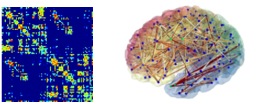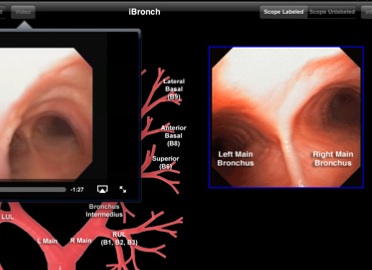OPEN PROJECTS
SEMESTER PROJECT PROPOSALS – Autumn 2013
|
1. Automatic face detection and recognition in the Montreux Jazz Festival digiral archives |
|
The MetaMedia Center is presently digitizing the audio and video archives of the Montreux Jazz Festival. In order to enrich the archive database, we propose to develop and run on this extraordinary database state-of-the-art face detection and recognition methods, in irder to enrich the indexing of this huge database. Existing codes will need to be evaluated, improved and adapted to allow maximum retreival rate in a selected subset of the archives. |
|
Requirements: basics in signal/image processing and/or machine learning. |
MASTER PROJECT PROPOSALS – Autumn 2013
|
MEDICAL IMAGE ANALYSIS PROJECTS |
|
1. Graph analysis to detect differences in human brain networks
|
|
Last decade advances in diffusion magnetic resonance imaging (dMRI) and in fiber tractography methods have permitted to characterize the human brain white matter structure and integrity and to determine in vivo its connectivity architecture. Both structural and functional brain connectivity are often represented in terms of graphs, with the nodes being the brain cortical regions, and the edges representing the structural (axonal) or functional (signal synchronization) relationship between these regions. This relatively simple way of modeling the brain connectivity enable the use of graph theory methods that can capture quantitative and qualitative aspects of the brain network (often referred as connectome). These aspects turn to be fundamental in the investigation of pathological conditions of the human brain.
|
|
Notice that other projects on brain image processing are available. Please contact Prof. Thiran if you are interested. Requirements: Image processing. Supervisor: Prof. Jean-Philippe Thiran |
|
2. Fusing real and vistual endoscopy for improving navigation in lung biospies |
|
Endoscopy is a powerful tool to perfom minimally invasive biopsies. It is largely used for biopsies of lung tissues in case of suspition of lung cancer. In this situation the pneumologist has to guide the endoscopic probe though the complex tree structure of the lungs to reach the pre-defined target position. The actual path from the entrance to the target is mentally visualized by the operato and at each branching in the pulmonary tree, he/she has to figure out where to guide his probe to follow the correct path. This is an extremely difficult mental task, prone to errors when the tree structure become complicated. To help him/her preparing this, 3D rendering of virtual endoscopy, extracted from 3D medcial images (namely computed tomography – CT scan) of the patient, has been developed. It allows to pre-visulaize the path on the 3D rendering and to virtually render the endoscopic view at different locations. The missing part of this system is the link between the real and the virtual endoscopy. In this project, we will develop this link : starting from a known location at th entrance of the pulmonary tree, the real movement of the endoscope, seen on the real endoscopic image, will be estimated and applied on the virtual endoscopy, to precisely follow both the location and the orientation of the endoscpe and visualize its position on the 3D CT volume of the patient. The following image gives an idea of the targetted system : the real and virtual enscopic images as well as the location of the endoscope mapped on a representation of the pulmonary tree. |
|
Requirements: C++, image processing |
FACIAL IMAGE ANALYSIS PROJECTS
|
3. Virtual view generation of faces from multiple cameras using appearance models
|
|
Frontal pose-based facial analysis (such as face recognition, facial expression analysis, eye-gaze tracking etc.) is a widely explored research field in computer vision literature. The state-of-the-art performances of such applications are nearly perfect on many of the databases. On the other hand, these applications are quite sensitive to large range of head movements which often occurs in real-world scenarios. The goal of this project is to generate frontal view of the face using images taken from one, two or several cameras. A face tracker will be used on each of those images to provide landmarks which will be used as correspondence points. This face tracker is already developed and used by our group. From the images and correspondence points, warping techniques can be used to generate a textured frontal view of the tracked face.
Requirements: The project can be performed in C++ or Python using OpenCV library. Good knowledge of at least one of the languages is therefore required. Basic knowledge in image processing, computer vision and computer graphics is also a big plus. Assistants: Gabriel Cuendet ([email protected]), Murat Arar ([email protected]) Supervisor: Prof. Jean-Philippe Thiran
|
|
4. Texture-Based Performance Measure Development for Face Tracking |
|
Face tracking is a very useful tool for various applications from facial expression recognition to intelligent human computer interaction and the range of conditions that it is used in growing along with the possible application areas. Although many robust face tracking algorithms have been proposed to work in such conditions there is no reliable measure of face tracking performance (i.e. a metric that can tell us how well the system tracked the face and the facial points). A most common method used is to compare the face tracking results with manually annotated points on the face, but this is a time consuming task and generally one does not find these points for the intended tracking sequence, let alone the subjectivity of these annotations. The appearance based cost functions that are used for fitting a trained face model are not reliable either, since they may provide the best possible solution within an image yet it does not necessarily mean a good enough solution. What we want to do within this project is to find measures from the texture that will allow us to assess the performance of the face tracker on a frame by frame basis. We will then compare these measures we obtain with the ones obtained by comparing the tracked shapes to the ground truth annotations on available databases. We will try different texture descriptors and template matching techniques and test the methods’ reliability on various face trackers. The obtained measure will be incorporated within a real-time face tracking system both to infer during tracking whether a re-detection of the face is required and to obtain the overall tracking performance on the videos that we use for different applications in our group. |
|
Requirements: The project will eventually be implemented in C++ so a basic knowledge is required. The student is also expected to have previous experience in basic image processing and Matlab programming. |
|
5. Automatic face detection and recognition in the Montreux Jazz Festival digiral archives |
|
The MetaMedia Center is presently digitizing the audio and video archives of the Montreux Jazz Festival. In order to enrich the archive database, we propose to develop and run on this extraordinary database state-of-the-art face detection and recognition methods, in irder to enrich the indexing of this huge database. Existing codes will need to be evaluated, improved and adapted to allow maximum retreival rate in a selected subset of the archives. |
|
Requirements: basics in signal/image processing and/or machine learning. |
REMOTE SENSING IMAGE PROCESSING & MACHINE LEARNING
|
6. Flood detection from Synthetic Aperture Radar images: the case study of Madagascar |
|
Climate-related disasters, mainly floods and wind storms, have significantly increased during the last decades. These natural disasters are particularly frequent in sub-tropical countries due to cyclones and hurricanes causing important infrastructure damages and life losses. There is really a need for reducing the impact of floods by efficient early-warning systems based on the detection of floods using satellite images. Remote sensing of the earth by satellite is widely used for covering large regions and Synthetic Aperture Radar (SAR) imagery provides images at day and night time and by any weather condition. This project focus on the case study of Madagascar which is strongly affected by floods. SAR images from ENVISAT satellite are available at different periods (before and during floods in february 2012). The goal of this project will be to investigate and compare different flood detection methods exploiting various machine learning techniques (change and novelty detection, kernel methods) and some a priori knowledge (e.g. Digital Elevation Model of the ground covered). |
|
Requirements: basic image processing/remote sensing, good matlab skills |
|
7. Dynamic Novelty Detection |
|
Monitoring our ecosystem accurately and over a certain time span is of first importance to be able to recognize tendencies, make predictions or take decisions. Climate change has been the center of interest for all the Earth observation community during the last decade, increasing the number of satellites and their accuracy and performing additional airborne campaigns. In this project we are interested in detecting abnormal evolution of vegetation from satellites. When an image before and after an event is available, change or novelty detection techniques allow to visualize zones of abnormality that can correspond to a problem of growth, man intervention or damages from natural hazards. A multi-temporal analysis, with a series of images of the same scenery in a chronological order, would reflect more precisely the vegetation dynamics (discretized samples). The goal of the project will be to establish a model of these vegetation dynamics in order to detect efficiently abnormalities. Methods like the Hidden Markov Model (HMM), widely used to describe dynamics, will be combined with recent machine learning methods for novelty detection allowing better discrimination. Images from the LANDSAT TM satellite will be used to experiment and validate the hybrid model. |
|
Requirements: basic signal/image processing, good matlab skills |
See also the projects proposed by Dr Yves Wiaux (LTS5 – BASP group)


